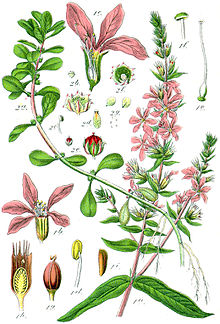Marsh whale
| Marsh whale | ||||||||||||
|---|---|---|---|---|---|---|---|---|---|---|---|---|

Marsh whale ( Lythrum portula ) |
||||||||||||
| Systematics | ||||||||||||
|
||||||||||||
| Scientific name | ||||||||||||
| Lythrum portula | ||||||||||||
| ( L. ) DAWebb |
Marsh whale ( Lythrum portula ) is a species of the blood loosestrife ( Lythrum ) within the loosestrife family (Lythraceae).
description
Vegetative characteristics
It is a prostrate, creeping, annual herbaceous plant with usually between 10 and 15 centimeters (exceptionally up to 40 or 100 centimeters) long, rooting stems. The stems can be colored intensely red. The leaves are fresh green or red overlaid - the latter when it is dry - and are obovate to spoon-like (spatulate) in shape. At their tip they are bluntly rounded, at the base they are narrowed into the stalk, and they are 6 to 22 mm long and 2 to 10 mm wide. There are also two tiny stipules in each case.
Generative characteristics
The flowering period extends from July to September. The hermaphrodite flowers are only 1 to 2 millimeters in diameter and are individually short-stalked in the leaf axils. Their sepals are glandular at the tip; the pink and white petals can sometimes be missing.
The double capsule fruit is spherical.
Chromosome number
The number of chromosomes is 2n = 10.
ecology
The rare in Central Europe Lythrum Portula-Zwergrüssler ( Nanophyes globulus - a weevil ) feeds monophag of Lythrum Portula; its larvae develop in the fruit capsules.
Occurrence
Marsh whale is common in most of Europe between southern Scandinavia and the Mediterranean . To the west-east its area extends from the Iberian Peninsula and Ireland to Russia; to the south, the north-west African Maghreb is barely reached. The swamp whale occurs in parts of North America, namely on the west coast of the USA and Canada as well as in Ohio - but there the species is not originally indigenous ("introduced").
It thrives from the lowlands to medium mountain ranges . In Central Europe this species can be found steadily in water-rich landscapes, but otherwise scattered to rare and inconsistent; it is absent in limestone regions and in the Alps.
The swamp quendel inhabits alternately wet, lime-poor locations in Europe. In terms of plant sociology, it is a class and order character of the dwarf rush communities (Isoeto-Nanojuncetea bufonii Br.-Bl. & R.Tx. 1943). The occurrence of these plant communities is characterized by a constant alternation of littoral (overrun with water) and limoser (superficially dry, but still moist) phases. The respective duration of these periods and their seasonal occurrence determine the species composition in addition to the soil conditions. Corresponding conditions can be found in very shallow still waters with alternating water zones, in damp, temporarily flooded depressions and other short-lived amphibious pioneer corridors.
Marsh whale thrives best on open, moderately nutrient-rich, but low-nitrogen and low-lime sand , loam and clay soils . It is considered to be a flood indicator (humidity number “7 =” according to Ellenberg ) and an acid indicator (reaction number “3”). Air-filled spaces in the root bark are an adaptation to oxygen-poor, waterlogged soils - such plants are called "helomorphic". The marsh marsh sprouts and grows under water, but only blooms and fruit after the site has dried out. The seeds spread by swimming after the water level has risen again.
Danger
In Germany, the marsh mace is on the red list in individual federal states , but is not considered endangered nationwide in 1996. In Switzerland, however, it is classified as “highly endangered” (EN).
Taxonomy
It was first published in 1753 under the name Peplis portula by Carl von Linné . The new combination to Lythrum portula (L.) DAWebb was published in 1967 by David Allardyce Webb . The specific epithet portula refers to the similarity of the leaves to those of purslane . Synonyms for Lythrum portula (L.) DAWebb are: Ammannia portula (L.) Baill. , Chabraea compressa Bubani .
Its systematic position is controversial - some authors consider it to be part of the genus Lythrum , others continue to follow or again the traditional classification into a separate genus Peplis made by the first descriptor Carl von Linné .
swell
literature
- Heinz Ellenberg : Pointer values of the vascular plants of Central Europe. Scripta Geobotanica IX, 2nd edition, Erich Goltze KG, Göttingen 1979.
- Henning Haeupler , Thomas Muer: picture atlas of the fern and flowering plants of Germany (= the fern and flowering plants of Germany. Volume 2). Published by the Federal Agency for Nature Conservation. Ulmer, Stuttgart 2000, ISBN 3-8001-3364-4 .
- Heinz-Dieter Krausch: Color atlas of water and bank plants. Ulmer, Stuttgart 1996, p. 279. ISBN 3-8001-3352-0
- Erich Oberdorfer : Plant-sociological excursion flora. Ulmer, Stuttgart 1990 (6th edition). ISBN 3-8001-3454-3
- Richard Pott: The plant communities in Germany. UTB, Ulmer, Stuttgart 1992. ISBN 3-8252-8067-5
Individual evidence
- ^ Lythrum portula at Tropicos.org. In: IPCN Chromosome Reports . Missouri Botanical Garden, St. Louis
- ↑ Identification key / information at www.coleo-net.de (A. Lompe)
- ↑ USDA: Natural Resources Conservation Service: Plant profile of Spatulaleaf loosestrife
- ↑ Peplis portula L., Gewöhnlicher Sumpfquendel. In: FloraWeb.de.
- ↑ Red List of Endangered Ferns and Flowering Plants in Switzerland 2002 (PDF download)
Web links
- Profile and distribution map for Bavaria . In: Botanical Information Hub of Bavaria .
- Marsh whale . In: BiolFlor, the database of biological-ecological characteristics of the flora of Germany.
- Lythrum portula (L.) DA Webb In: Info Flora , the national data and information center for Swiss flora . Retrieved December 27, 2015.
- Datasheet with photos and distribution in the Netherlands. (Dutch)
- Distribution in the northern hemisphere at linnaeus.nrm.se
- Thomas Meyer: Data sheet with identification key and photos at Flora-de: Flora von Deutschland (old name of the website: Flowers in Swabia )




